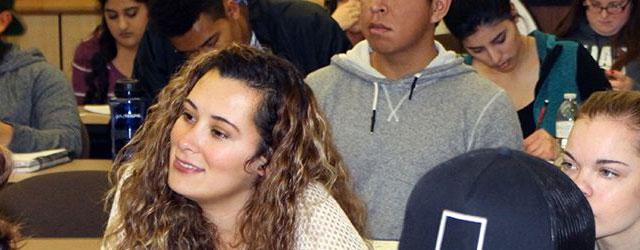SubMenu
Understanding Course Repetition & Withdrawal
State regulations regarding course repetition and withdrawal were modified in Summer 2012. These changes affected all California Community Colleges.
Enrollments which resulted in an A, B, C, D, F, FW, P, NP, or W count as a course repetition under the 2012 rules.
Change #1 – The Withdrawal Timeline
The withdrawal period will changeed from the end of the fourth week to the end of the second week. This means that students began receiving W's two weeks earlier than in past semesters. For irregular term courses, the withdrawal date changeed from the 25% point to the 20% point.
Change #2 – Limitation On Withdrawals
Regulations limited the maximum number of withdrawals in any one class to three.
Change #3 – Withdrawals Count As Attempts
Under the 2012 procedures when a student enrolls in a class and subsequently withdraws, receiving a "W" on their record, that enrollment counts as a repetition. See course repetition grid below for existing limitations.
Change #4 – Limitations on Repetitions
There are limitations which restrict the total number of attempts in any one course. See chart below for details.
|
Course Type |
Non-Repeatable Courses |
Repeatable Courses |
Variable Unit Courses |
|---|---|---|---|
|
Description: |
The majority of courses fall into this category. When students pass a class in this category they cannot repeat the course. First two substandard grades are alleviated by rule. |
Student may enroll in repeatable courses up to 4 times (see catalog). Under certain conditions, up to two substandard grades may be alleviated by petition. |
Student may enroll without limitation up to the maximum number of units listed on the course outline (see catalog). Under certain conditions, up to two substandard grades may be alleviated by petition. |
|
1st Attempt: |
If passing (A, B, C, or P), stop. If substandard (D, F, FW, NP, or W), repeat allowed. |
Enrollments resulting in A, B, C, D, F, FW, P, NP, or W count as an attempt. |
If passing (A, B, C, or P), and student has used max. units, stop (exemptions listed below). If substandard (D, F, FW, NP, or W) or max. units not earned, repeat allowed. |
|
2nd Attempt: |
If passing, stop. Prior substandard grade is alleviated. If substandard, student may repeat one additional time with permission from Counseling. |
Enrollments resulting in A, B, C, D, F, FW, P, NP, or W count as an attempt. Prior substandard grade may be alleviated (requires petition; max. of 2). |
If passing, and student has earned max. units, stop (exceptions listed below). If substandard or max. units not earned, repeat allowed. Prior substandard grade may be alleviated (requires petition; max. of 2). |
|
3rd Attempt: |
If passing, stop. Both prior substandard grades are alleviated (3rd and subsequent grades are counted). If substandard, student cannot repeat again unless they qualify for an exception (listed below). |
Enrollments resulting in A, B, C, D, F, FW, P, NP, or W count as an attempt. Prior substandard grade may be alleviated (requires petition; max. of 2). |
If passing, and student has earned max. units, stop (exceptions listed below). If substandard or max. units not earned, repeat allowed. Prior substandard grade may be alleviated (requires petition; max. of 2). |
|
4th Attempt: |
N/A |
Enrollments resulting in A, B, C, D, F, FW, P, NP, or W count as an attempt. Student cannot repeat again unless they qualify for an exception (listed below). Prior substandard grade may be alleviated (requires petition; max. of 2). |
If passing, and student has earned max. units, stop (exceptions listed below). If substandard or max. units not earned, repeat allowed. Prior substandard grade may be alleviated (requires petition; max. of 2). |
|
5th & Subsequent Attempts: |
N/A |
N/A |
If passing, and student has earned max. units, stop (exceptions listed below). If substandard or max. units not earned, repeat allowed. Prior substandard grade may be alleviated (requires petition; max. of 2). |
Exceptions
Exceptions can be made to the course repeat procedures under the following circumstances:
Significant Lapse of Time – Students may be permitted or required to repeat courses in which an "A, B, C, or P" grade was earned where there was a significant lapse of time, defined as no less than 36 months since the grade was obtained, and:
- the District has established a recency prerequisite for a course or program; or
- an institution of higher education to which a student wishes to transfer has established a recency requirement that the student cannot satisfy without repeating the course.
Extenuating Circumstances – Students may be allowed to repeat a class one time in order to improve a grade when the previous grade resulted, in part, from a verified accident, illness, or other circumstance beyond the control of the student.
Mandated Training – Students may be allowed repeat a course without limitation in order meet a legally mandated training requirement as a condition of paid or volunteer employment.
Degree, Certificate, Transfer – Students may be allowed to repeat a course one time (max. of three per student) when that course is necessary to meet a degree, certificate, or transfer requirement.
Additional repetitions may be approved by the Academic Council under certain circumstances.
Content editor:
Julie Scarpelli
530-895-2511



